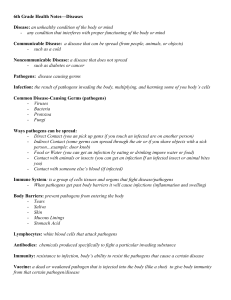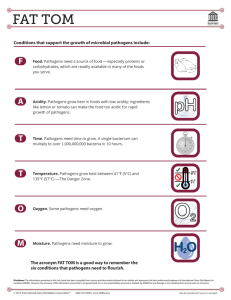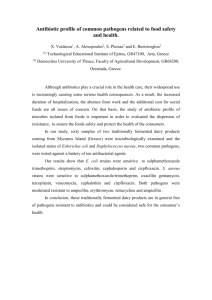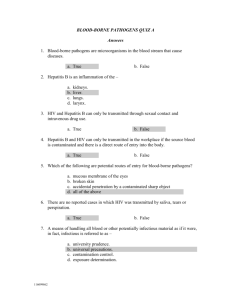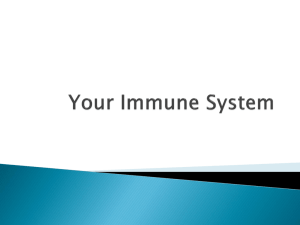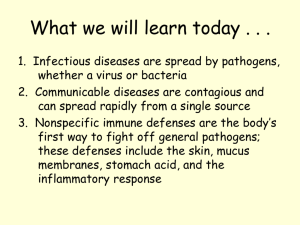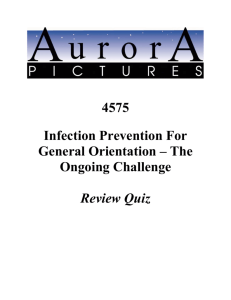blood borne pathogens - the Branford Fire Department
advertisement
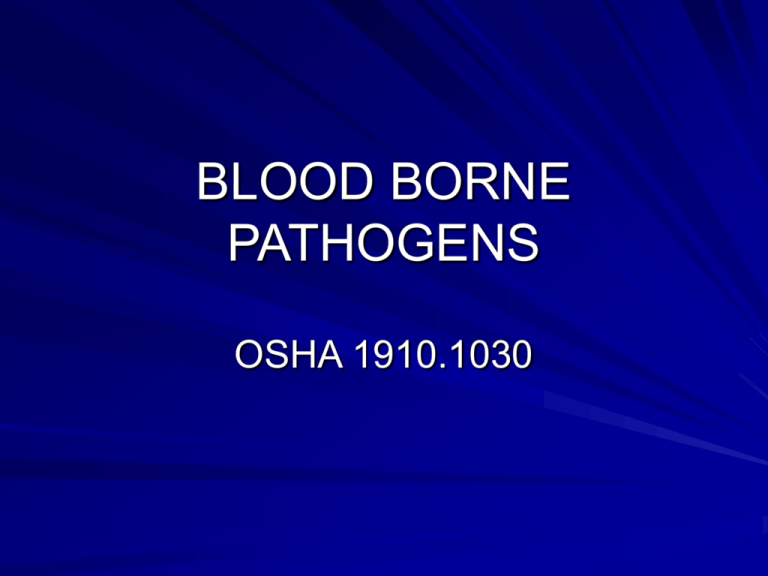
BLOOD BORNE PATHOGENS OSHA 1910.1030 BLOOD BORNE PATHOGENS REQUIREMENTS – – – – Employer must have written policy Employer must train all employees Employer must provide necessary PPE Employer will provide workplace practices and engineering controls to reduce exposures _ Employer will insure appropriate medical treatment to exposed employees at no cost. _ All medical information will be kept confidential BLOOD BORNE PATHOGENS Firefighters may be exposed to blood and/or other potentially infectious materials OPIM. Communicable Diseases- capable of being passed from person to person. Examples: Hepatitis A,Hepatitis B, Hepatitis C, Hepatitis Non A, Non B,HIV Non-communicable diseases- food poisoning BLOOD BORNE PATHOGENS Modes of Transmission – Direct contact through skin or mucous membranes. Blood or OPIM through open cuts or wounds. Blood or OPIM into eyes, mouth, nares. Unprotected homosexual or heterosexual contact. – Casual contact, eating utensils, beds, toilets is not a means of disease transmission. BLOOD BORNE PATHOGENS Risk of transmission extremely low or nonexistent; – Feces – Saliva – Sweat – Urine - nasal secretions - sputum - tears - vomitus Unless visible blood is present. BLOOD BORNE PATHOGENS Putting yourself at risk – Having homosexual or heterosexual contact via oral, anal or vaginal route with someone who is infected. – Sharing a needle with an infected person. – An infected female may pass disease to her baby during pregnancy or childbirth. BLOOD BORNE PATHOGENS Occupational Risk Factors – Uncontrolled situations, fights, shootings, vehicle extrications. – Home deliveries of children – Cardiac arrests – Industrial Accidents BLOOD BORNE PATHOGENS Protecting yourself – PPE - Minimum is a pair of gloves Eye protection may be required Full gown, booties may be required If it’s wet and it isn’t yours don’t touch it!!! BLOOD BORNE PATHOGENS Diseases – HBV- Caused by a virus. Attacks the liver Severity ranges from mild to fatal. 25% of infected individuals develop acute hepatitis Of infected individuals 6-10% well become carriers Carriers are at risk of developing chronic liver disease. BLOOD BORNE PATHOGENS HBV (cont.) – Active hepatitis – Cirrhosis – Primary liver cancer – Infectious to others BLOOD BORNE PATHOGENS How widespread is HBV – 1 out 20 people in the US will become infected some time during their lives. – Estimated 1.25 million chronically infected Americans. Greater risk if parents born in Southeast Asia, Africa, Amazon Basin of South America, the Pacific Islands or the Middle East. BLOOD BORNE PATHOGENS Hepatitis c – Caused by a virus. – Attacks the liver. Long Term Effects - Chronic liver disease - Cirrhosis - Liver Cancer - Fatal BLOOD BORNE PATHOGENS HIV- Human Immunodeficiency Virus – Some individuals exhibit no signs. – More severe symptoms include loss of appetite, weight loss, fever, night sweats, skin rashes, diarrhea, tiredness, lack of resistance to infection, swollen lymph nodes. – May progress to AIDS- lowers the body’s defense against disease. BLOOD BORNE PATHOGENS HBV Vaccination Program – Free to all members – Declinations must be signed if not receiving vaccination – Boosters and Titer if indicated/ required by OSHA/CDC will be offered free f charge. – If vaccination initially refused may be rescinded anytime during employment. BLOOD BORNE PATHOGENS Exposures – Actual- needle stick, blood or OPIM in open cut or in mouth, nose, eyes. – Medical treatment- hospital or Occupational Medicine – Injury report form. – Communicable disease report form. BLOOD BORNE PATHOGENS Suspected – Blood or OPIM in contact with intact skin. – Wash area with soap and water or appropriate cleansing agent. – Document incident. BLOOD BORNE PATHOGENS Equipment Maintenance – Protect yourself during equipment decon and cleansing. – Some viral agents may survive up to 7 days in dried blood. – Gloves should always be worn. – Eye protection may be required when using solutions. BE SMART. STAY SAFE. AIRBORNE PATHOGENS Communicable diseases – Tuberculosis – SARS – Whooping cough – Flu Spread by inhalation of airborne droplets from cough of infected persons. AIRBORNE PATHOGENS Tuberculosis – An infectious disease – Characterized by inflammatory infiltrations and the formation of tubercules, abcesses, fibrosis and calcifications – Most commonly affects respiratory system Spread through airborne droplets containing tubercle bacilli. AIRBOREN PATHOGENS Tb (CONT.) – Can also affect the gastrointestinal and genitourinary tracts, nervous system, bones, joints, lymph nodes and skin. Infection is usually acquired from contact with an infected person. AIRBORNE PATHOGENS The Path of Transmission – The air droplets are inhaled by people in the close proximity of the infected person. – In some individuals the tubercle bacilli will enter the alveoli and establish an infection. – Within weeks of the initial infection, it can spread through the lymphatic system to distant tissues and organs. – Develops an active infection/ AIRBORNE PATHOGENS – Latent TB Infection Tubercle bacilli enters the body through alveoli Immune response limits multiplication and spread of the bacterium. Some bacterium remain dormant and viable for years or decades. May become “active”. AIRBORNE PATHOGENS Signs and Symptoms – Productive cough (usually greater than two weeks in duration). – Extreme weight loss (greater than 15 lbs. in one week). – Persistent fever – Night sweats – Bloody sputum – Anorexia AIRBORNE PATHOGENS Groups with High Risk of Contracting TB – Persons with HOV infection – Alcoholics and IV drug users – Residents of long term care facilities – Low income populations – Foreign born persons from high prevalence countries. AIRBORNE PATHOGENS Medical Conditions With Increased Risk – HIV Infection – Immunosuppressive therapy – Diabetes Mellitus – Prolonged Corticosteroid therapy – End stage renal disease – Hematological diseases – Carcionmas of oropharynx and upper GI tract AIRBORNE PATHOGENS Procedures posing increased risk of exposure – Endotrachael intubation – Administration of aerosolized treatments – Suctioning/sputum collection – Any cough producing procedure Administration of oxygen Auscultation of deep lung sounds. AIRBORNE PATHOGENS Minimizing the Risk – TB screening process – Personal protective equipment – Adjusting field practices AIRBORNE PATHOGENS Screening for TB Infection – Intradermal Mantoux test Initial physical Known or suspected exposure As determined by risk assessment. AIRBORNE PATHOGENS Screening Results- Positive PPD Results – Chest X-ray – Clinical evaluation – Preventative therapy – Monitor for signs and symptoms of TB. – Reported to State Department of Healthrequired by regulation. AIRBORNE PATHOGENS PPE– N-95 Masks Requires annual fit testing – “Simple” surgical masks for TB patient – Cleaning procedures AIRBORNE PATHOGENS N-95 Masks – Worn in high risk areas Convalescent homes/rooms Jails Trailers Any close living arrangement AIRBORNE PATHOGENS Reporting unprotected exposures – Immediately seek medical advice from the receiving hospital. – Injury report form – Communicable disease form. – Contact Infectious disease control officer.
